SixStringers Wild Plectrums is an American boutique pick company launched in 2017 by Steven Bolson. When I reached out to him about reviewing his picks, we had the most interesting conversation I’ve ever had about guitar picks. We went over the materials he uses and why he chose them, how each affects the sound, and how hard it is to isolate the different properties that control a pick’s tone.
SixStringers Wild Plectrums uses a wide variety of high-quality materials (which we’ll get into later on) and gauges, but only one shape. In any other situation, I’d probably say that the shape is the main unique selling point of these picks, but in this case, the materials he chose play a huge role, too.
Table of Contents
The SixStringers Guitar Picks I’m Reviewing Today
For this review, I got 26 different picks, almost every pick SixStringers make.
- Acrylic – 1.5mm, 2mm, 2.5mm, and 3mm
- Aluminum Alloy – 1mm
- Graphtex – 1.27mm and 3mm
- IROC – 0.73mm, 0.83mm, 1mm, 1.27mm, 1.5mm, 2mm, 2.5mm, 3mm and 6mm
- PEEK – 0.6mm, 0.73mm, 0.86mm, 1mm, 1.25mm, and 1.5mm
- UMHW-PE – 1.5mm, 2mm, 2.5mm, and 3mm
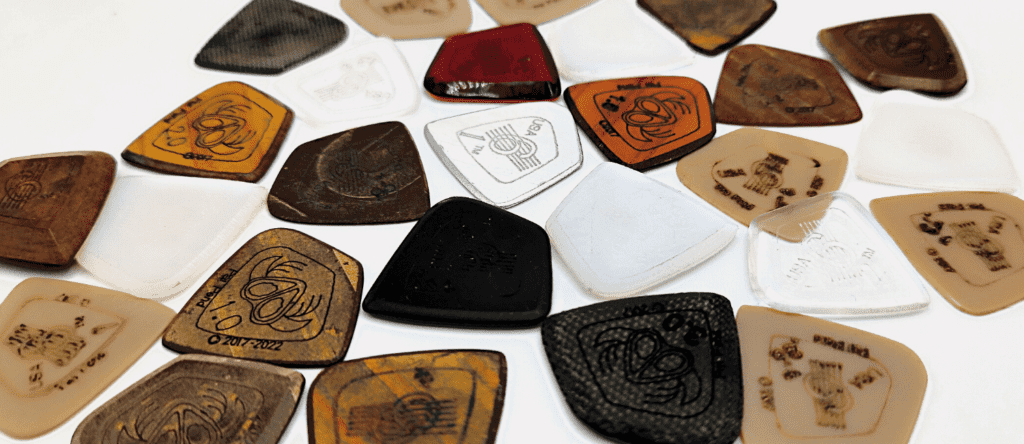
My First Impression
They say that the first impression matters the most, and they are not wrong. But having such a lengthy and interesting conversation with Steven before having the picks in my hands definitely increased my expectations. I did my best to keep them at bay, but you know how it is…
The first pick I took was the 6mm IROC, which was the reason I reached out to Steven in the first place. As soon as I held it, I knew it was something special. My already high expectations were satisfied.
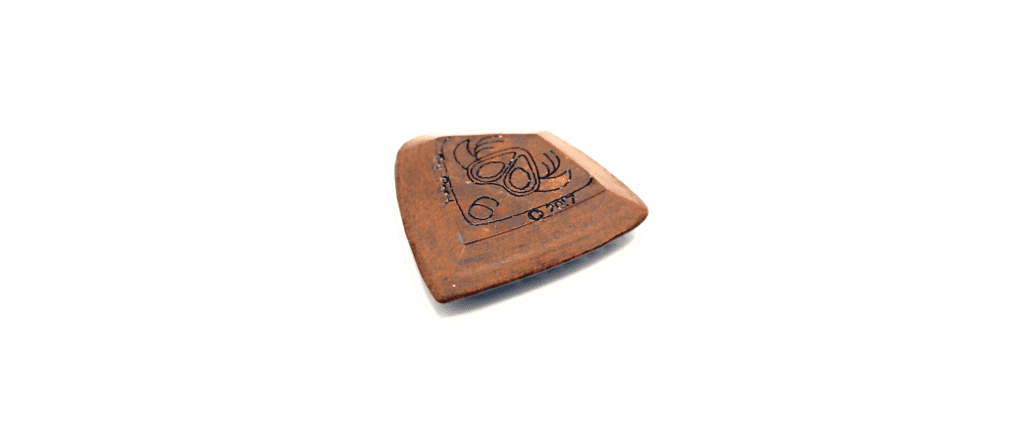
The SixStringers Unique Guitar Pick Shape
Other than the materials, the shape, too, is unique. It has four playing tips, each designed for a different purpose.
While triangle picks are fairly common, quad picks are challenging to design. The sum of the angles of a triangle is 180 degrees, making the average tip angle around 60 degrees, which is very reasonable. I say “around” because most picks are not made of straight lines, and the curves widen the angles. Quad picks, on the other hand, have an average angle of 90 degrees, which is quite wide for a pick.
Another challenge in designing a quad pick is the need for symmetry. When you hold a pick against the strings, it needs to have the same angle stroking up and down. Otherwise, it becomes unpredictable, hard to control, and all over the place in terms of dynamic range.
Anyway, back on the subject, each pick has four playing tips designed for a different purpose, and the bevel is consistent across all tips and materials.
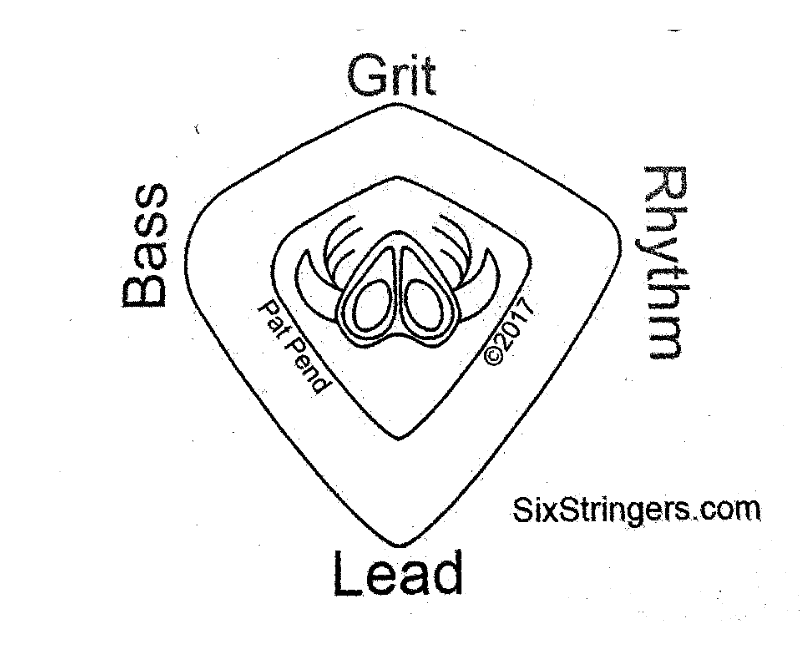
Bass
The bass tip is the second widest of all tips, but it is the roundest. The long diameter of the tip mellows the sound, allowing any experienced bass player to control exactly how much brightness they want by angling the pick differently. The parallel the pick is to the floor, the brighter the attack.
Grit
When you look at this tip, you may, at first, think that it’s too wide to be useful. In that case, let me try to convince you otherwise.
When you’re playing with extremely high gain, you’ll want as little dynamic range as possible to sound consistent. The biggest and most sudden change in volume occurs in the first few milliseconds of every note, right after the string is released from the pick. This is exactly what this tip is made for. It acts almost like a compressor, lowering the volume of the attack. Unlike a compressor, though, you can still control how much of it to apply in each pluck.
Additionally, and not as intended, I like it when I play funky strums, clean with a wah pedal.
Lead
The lead tip is about as wide as the tip of a flow pick (the angle it gets to right before the tip, thanks to its curve). It provides a balanced attack, giving the material enough space to be the star of the tone. This is very apparent when I compare the lead and rhythm tips back to back.
Rhythm
The rhythm tip is the second sharpest and the second roundest tip. The relatively sharp angle, together with the long diameter, balances the need for accuracy with the need to stay in the background and not interfere with the lead. It’s a delicate balance that I think SixStringers got absolutely right.
Materials
Acrylic
Acrylic is bright, making it very balanced on the rhythm and bass tips. I liked it on Grit and Lead, too, but not as much as other picks in this collection.
It’s not the fastest, but if you already have some Acrylic picks in your collection, this would be a great opportunity to examine the usefulness of the shape.
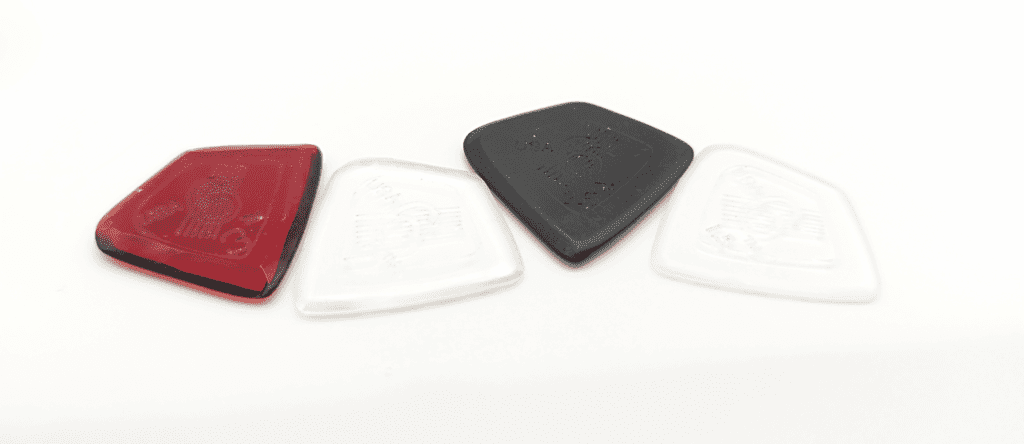
Aluminum Alloy
This material caught me by complete surprise. I’m not a big fan of Aluminum picks, or at least that’s what I thought. I tried TeckPick once or twice, and over the years, I got myself a ProPick, too. Both found themselves at the bottom of the pick jar quite fast.
Not this one, though. This pick provides a surprisingly warm sound, and it seems to be a lot easier on the strings, too.
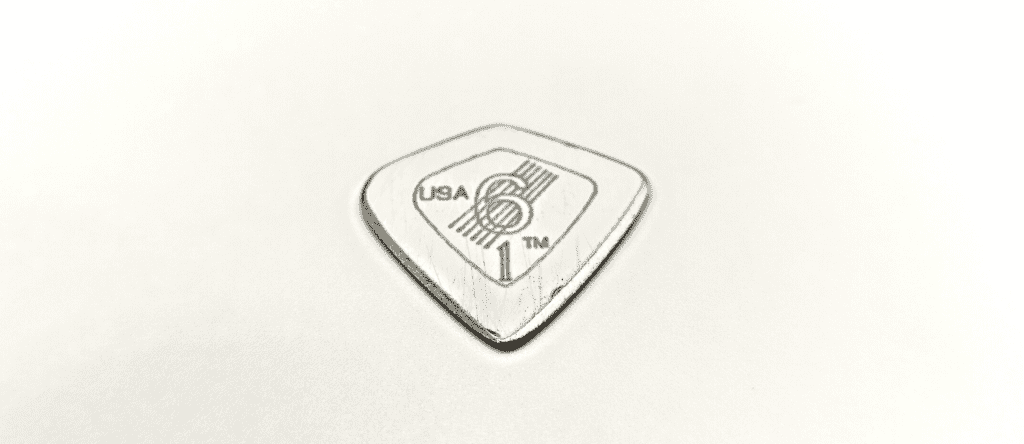
Graphtex
Graphtex is hard to describe. It feels like someone dipped fabric in molten Graphite and let it harden. The fabric is probably there to bind and harden the material in the same way they use steel bars to reinforce concrete.
It sounds warm and mellow, with no string noise, and yet, it has soft scratchy attack that’s perfect for saturating clean lines. It leaves some black residues on the hand after a few minutes, very similar to Dragon’s Heart picks. And I couldn’t find any sign of wear after about two months of moderate use, which was very surprising.
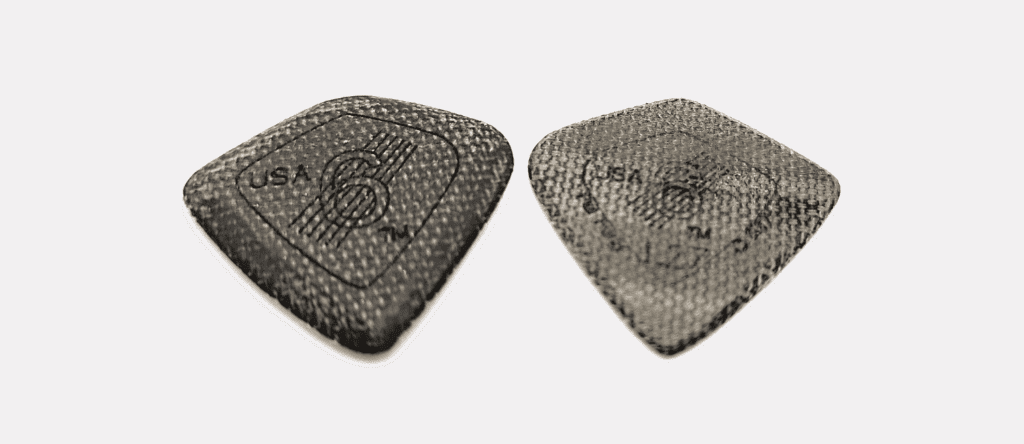
IROC
IROC is definitely the star of this review. There’s nothing about it that I don’t love, and the fact that I got to test the 6mm (my favorite gauge) version of it didn’t help me pay more attention to other picks, either. It’s warm but not dull, and the shape allows its attack to spark when you want it to. It’s lightning-fast, and it will last for eternity.
IROC stands for Industrial Resin Organic Composite. Don’t let the word “Resin” fool you, this pick is unlike anything else you’ve tried. It’s very similar in how it plays to other high-performance materials like PEEK, but smoother.
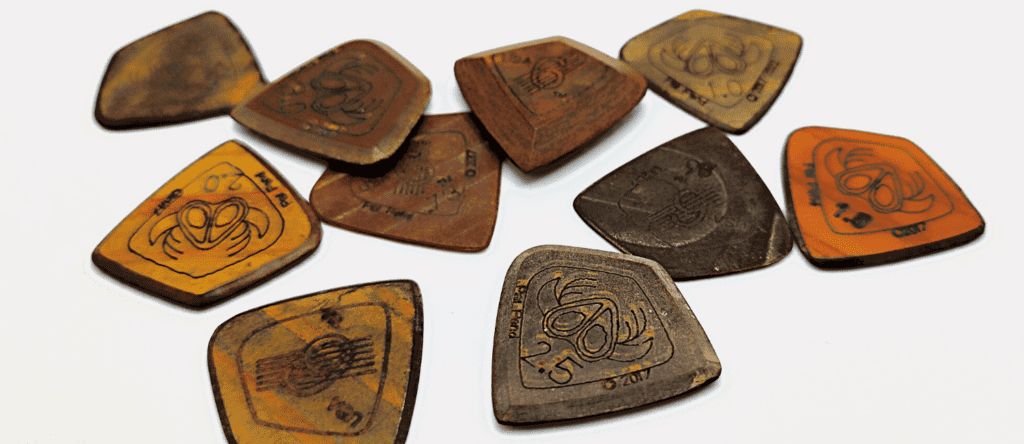
PEEK
PEEK, or by its less popular name, Polyether ether ketone, is a high-performance plastic used to produce parts for the aerospace, automotive, and chemical industries. Oh, and guitar picks.
Even though it sounds warmer than I expected, its texture is a bit rough, helping the attack shine with a bright burst. It’s a very fun pick to play, and being this tough, I even enjoyed the thinner gauges. In fact, I think this is the perfect pick for songs that require both strumming and playing lines.
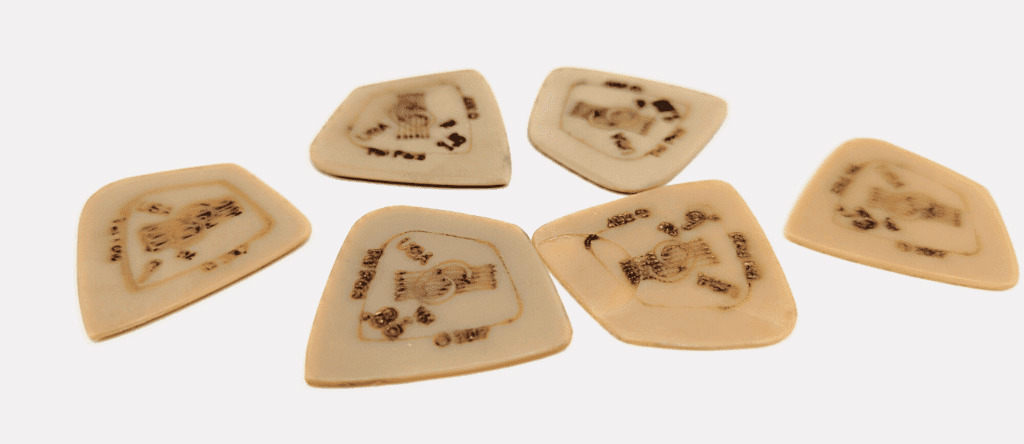
UHMW-PE
UHMW-PE is a high-performance thermosetting plastic, known for its self-lubrication qualities. Knowing that SixStringer doesn’t taper their picks (and understanding how much of a mess it would be to taper a four-sided pick), I was curious to see how they overcame the slipperiness of UHMW-PE.
What he did was to add a recess to one of the sides, where the thumb (or index finger) can sit comfortably and prevent the pick from moving. It works very well, no matter which tip you are using.
Of course, the same quality that causes this pick to be hard to grip is the same that makes it glide like butter across the strings and have no pick chirp. This, together with its warm and full tone, are the reasons why it is one of my favorite materials for picks.
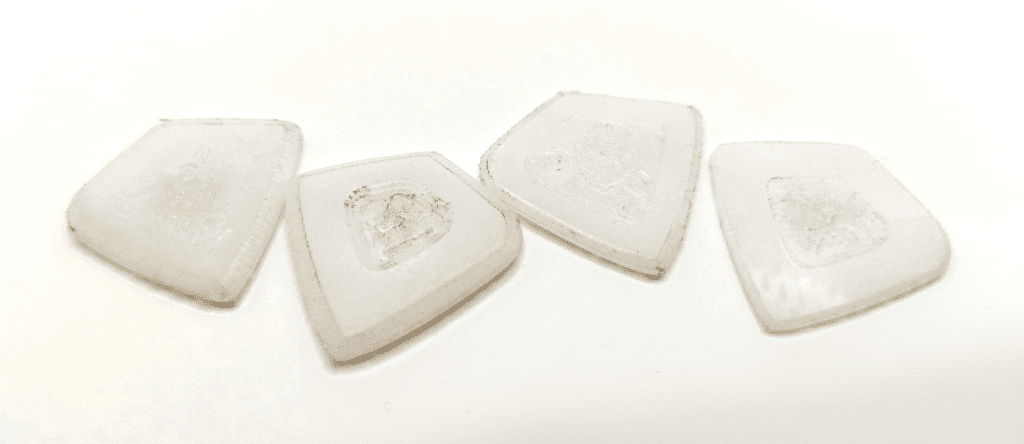
Pricing and Where to Buy SixStringers Guitar Picks From?
Like many boutique pick makers, SixStringers’ pricing is affected by the cost of material and the gauge of each pick. There are some really cheap picks like this Polycarbonate pack that cost $10 for 4 picks, and the price go up to $30 for the thicker PEEK picks. The pricing is very fair, especially since there’s free shipping for US customers.
You can buy them from their Etsy shop, their Reverb shop, or their Heavy Repping shop.
Finishing Thoughts
I can’t think of a guitar player that won’t find a pick they like in this range. I, personally, am not too comfortable with thin picks, but when I put SixStringer’s thin IROC or PEEK against other thin picks in the market, there’s no comparison. When it comes to thicker picks, they sound great, glide effortlessly, and the four tips are a huge advantage, too.
Disclosure
The picks were loaned to me for the sake of this review. It, however, didn’t change the way I wrote about them or the final score I gave them.
SixStringers Wild Plectrum Final Score
This was a real mindblower for me. Everything from the original shape, choice of material, accurate beveling, and tone was amazing.
The sound and feel are superb, there are many incredible materials to choose from, and the price is extremely fair. This is the whole package.
-
Sound
-
Feel
-
Variety
-
Price